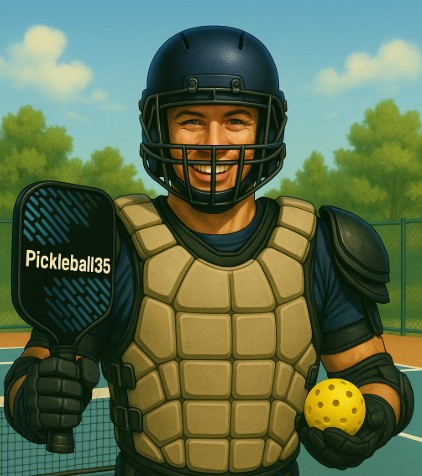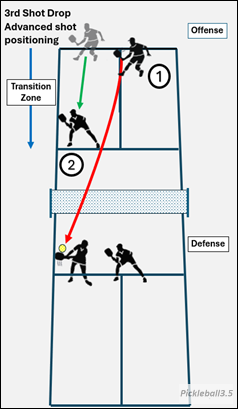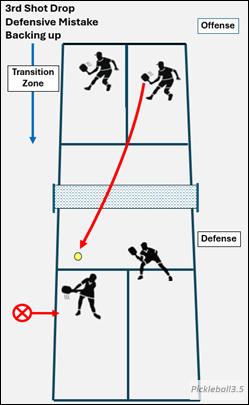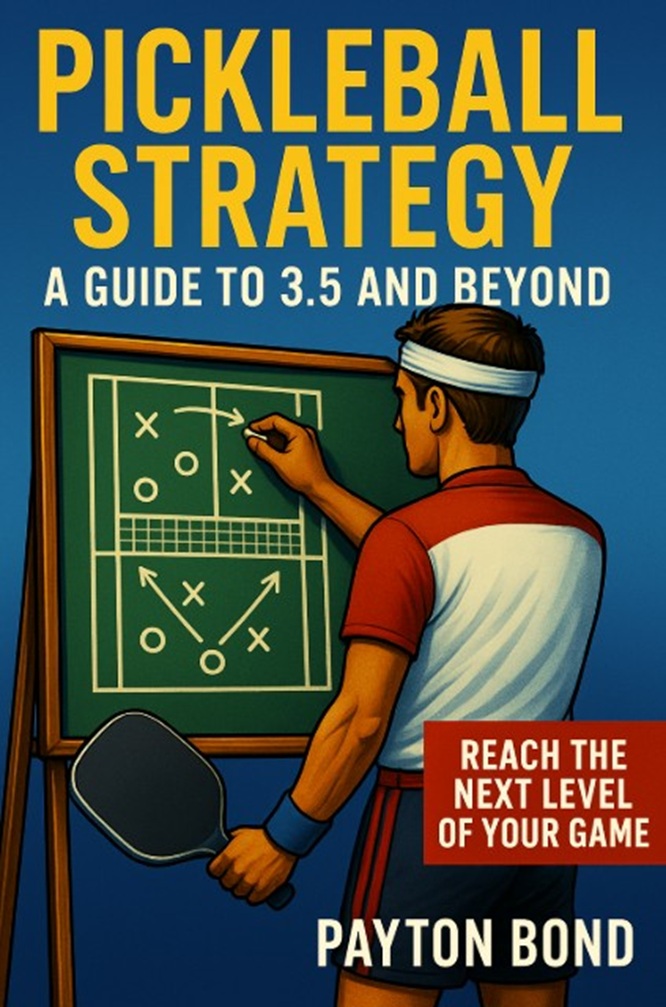
If you landed here from a search and feel this content lacks context, check out the foundational post on the Third Shot Drop:
Pickleball Third Shot Drop – Your Best Third Shot Option
Volley Back the Third Shot Attempt
In the illustration below a drop shot is hit to the outside of the court at the backhand side of the defensive player.

This is a pivotal moment—the pressure is on, and your response can make or break the rally. If the drop shot is subpar, reachable, and above the net, seize the moment with a forceful smash or a sharp, angled volley to end the point.
- If the drop shot is well-executed and you can’t put it away but can still reach it, volley with purpose:
- Use your court vision to see which opponent is further back and target them. This is usually the player who hit the drop shot as their partner may already be advancing as soon as they hit it.
- If both are advancing like they’re storming the gates, don’t panic and aim your volley across the court to the feet of the more distant player. Don’t give the closer one a freebie!
- Volley any reachable drop shots to your opponent’s feet, and preferably on their backhand side. Nothing says “not today” like a well-placed counter.
- Beware of upward motion volleys. A pop-up volley is exactly the gift they’re waiting for. Instead, keep your returns low and sharp. If they’re far enough back, you can safely land it in front of them.
If you are facing a good drop shot that will force an upward motion return, don’t panic—play a volley dink shot or just a normal dink after the bounce that barely clears the net in front of them. This soft dink shot just clears the net and many times is your only good option. If you attack a good drop shot you may either hit it up right at the charging opponent or hit it into the net. It is better to concede your opponent has hit a good drop shot and get into a dinking rally.
Hitting a return dink off a drop shot is a way of saying, “Nice Shot, let’s play this point out with Dinks.” Aim the dink shot cross-court and away from the player right in front of you if you can.
In summary, you have the advantage—don’t let it slip away.
Make your opponents work for every inch of the court. Skilled opponents will return your response volley back with a 5th shot drop and continue to hit drop shots at you and try to advance slowly to the net.
Drop Shot Defense Mistake -Backing Up
In the illustration below a third shot drop is hit to the outside of the court at the backhand of the defender. The defender isn’t confident to play a volley shot or dink back and they backup from the kitchen line.

Backing up at the line is one of the biggest missteps you can make in pickleball. It’s usually a result of uncertainty: Is the drop shot going to land just out of reach? Can you volley it effectively? That hesitation pulls you out of an offensive position and hands the advantage right over to your opponents.
In that moment, you’re like a deer in the headlights, staring at the drop shot, unsure whether to stand your ground or retreat. Backing up might feel like a safer choice, giving you more time to react, but in reality, it puts you on the defensive and often leads to losing control of the rally.
Always hold your ground at the kitchen line and volley the drop shot whenever possible to keep your opponents back.
Remember: pickleball rewards those who stay sharp and assertive, not those who retreat!
Your Opponents Will Take Advantage
If your opponent notices you’re always letting their drop shots bounce, they’ll gleefully advance to the kitchen line—sometimes even on mediocre shots—because they know you’re giving them extra time to move up.
If you have a good forehand shot with topspin, you may instinctively let the ball bounce so you can reposition and play your comfortable forehand shot. A high bounce might give you the chance to drive the ball effectively at your opponent or to an open spot, but if the bounce is lower, your odds of success shrink. Driving a low ball often leads to a shot into the net or flying out of bounds. Generally, any ball lower than net height and near the kitchen should be considered unattackable and trying to play these shots isn’t a good strategy.
Even if you manage a solid return off the bounce, your opponents are now comfortably stationed at the kitchen line, ready to handle any shot coming their way above net height. At that point, the momentum has shifted in their favor.
When faced with a good drop shot that lands in the kitchen, you may have no choice but to dink it back. In these cases, you might need to adjust slightly backward to make the shot, but this is the only time stepping back is acceptable.
Holding your position at the kitchen line also means effectively hitting backhand volleys. Skilled opponents will target your backhand with their third-shot drops. Hitting a backhand volley while reaching over the NVZ is no easy task. You need to practice and drill on this shot a lot until you can play it effectively.
Summary of Pickleball Drop Shot Defense
In summary, only back up to defend against a drop shot when it’s absolutely unavoidable.
Stay positioned and learn to volley drop shots back at your opponent’s feet and at their backhand.
By mastering this one skill, you’ll see a noticeable improvement in your game—especially when facing strong opponents who love to test your defenses. Stay sharp, stay positioned, and take control of the court!
Check out Payton Bonds new eBook!
Pickleball Strategy – A Guide to 3.5 and Beyond
See it on Amazon.

👤 Follow Payton Bond
All Star and Top Contributor on multiple Facebook Pickleball Forums.
Contributor at TheKitchenPickle.com.
Visit Payton Bonds Facebook Page
Keep Learning:
- Watch the Ben Johns video 🎥 below on Drop Shot defense.
- Read the next post in the Third Shot series: The Pickleball Reset – Slow Things Down and Get Out of Trouble.
🎥Watch Ben Johns Backhand Roll shot
Video courtesy of Ben Johns
Watch Ben Johns video on the Pickleball backhand roll shot on Youtube.

